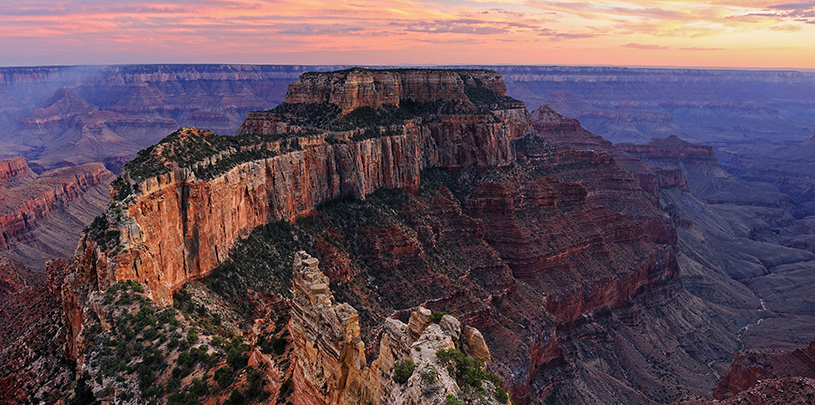
 by Amber Reimondo, Energy Director
by Amber Reimondo, Energy Director
On February 26, 2019, the centennial anniversary of Grand Canyon National Park, Rep. Raúl Grijalva introduced the Grand Canyon Centennial Protection Act to permanently protect public lands around the park from new uranium mining.
Even before the bill was introduced, fictitious claims about it began circulating. To help you navigate these murky waters, here are the facts about the Grand Canyon Centennial Protection Act, and the temporary mining ban it would make it permanent.
In 2012, the secretary of the interior instituted a 20-year mineral withdrawal, temporarily banning new mining claims on about 1 million acres of federal public lands bordering Grand Canyon National Park. The ban affects federal lands only — mostly national forest and lands managed by the Bureau of Land Management. State lands and private inholdings within the withdrawal area are not affected by the ban. The Grand Canyon Centennial Protection Act simply makes that 2012 withdrawal permanent. It does not transfer ownership of any lands to the federal government.
The act would not affect other existing uses, including:
One rumor circulating early on has been that the act, if passed, would close roads to off-road vehicle users and prevent future off-road-vehicle road construction. The only roads the act would stop from being built are roads leading to new mines and mining claims. The act aims to prevent one and only one activity around the Grand Canyon: mining.
In August 2018, a bipartisan poll found that 63 percent of Arizonans supported continuing the existing ban on new uranium mines near the Grand Canyon, including the majority of Democrats, Republicans, and independents. Seventy-three percent of Arizonans polled said outdoor recreation and visitors to national parks and other public lands are more important to the future of Arizona’s economy than mining uranium and other minerals.
The Arizona Wilderness Act of 1984 was designed to protect wilderness around the Grand Canyon. Protecting the region and its waters from mining contamination has been a separate but ongoing struggle. Mark Trautwein, a former staffer for the House Subcommittee on National Parks, Forests and Public Lands who was directly involved with the passage of the 1984 Arizona Wilderness Act, has testified before the same committee that the Arizona Wilderness Act was narrowly designed “to ensure that wilderness resources and values were protected.” His testimony also states that the committee’s former chairman, Mo Udall, “hoped for nothing less” than that others might someday add to his conservation legacy with legislation such as a bill that would permanently ban mining in the region.
Uranium mining around the Grand Canyon has never been, and never could be, a significant driver of the regional economy. That’s because mines are depleted relatively quickly and employ a relatively small number of people. The operator of Canyon Mine, near the South Rim, for instance, estimates that the mine will be depleted within 10 years and expects to employ approximately 60 people during peak operation. In the 2000s, including in 2007, when the price of uranium spiked to an all-time high, extraction of minerals including oil, gas, coal, nickel, zinc, copper, stone, iron, and uranium together provided an annual average of just 545 jobs in northern Arizona. Compare that to the more than 9,000 jobs supported by Grand Canyon National Park alone.
Finally, uranium mining is regulated under the antiquated General Mining Law of 1872, which means that while uranium mining companies still have to pay business taxes like any other business in the state of Arizona, they do not pay royalties on uranium extracted from public lands. Royalties paid by other extractive industries are split between the federal government and the state where the extractive operations take place and often help to support things like public education.
The U.S. has access to enough already mined uranium to meet the nation’s defense needs, supply its electrical grid, and insulate itself from disruptions in the supply chain. U.S. nuclear power companies have said that "buy American" requirements for uranium will drive up costs and force the closure of nuclear power plants. And finally, the Grand Canyon is hardly the linchpin to domestic uranium supply. Uranium deposits are common throughout the country and world, and the Grand Canyon region holds just 0.29 percent of known U.S. reserves of uranium.
Mining has left a toxic legacy in the Grand Canyon region that is still impacting human health and the environment today. Even more recent mines have experienced problems, demonstrating the dangerous lack of understanding about the complex interconnectivity of nearby groundwater and the Grand Canyon itself.
To make matters worse, the temporary mining ban of 2012 was meant to allow time for more research to better understand the risks to groundwater, land, plants, animals, and people in and around the Grand Canyon. But that research has been severely underfunded by Congress. The Grand Canyon Centennial Protection Act cuts to the chase and protects the Grand Canyon and those who depend upon it from the risk of contamination by new uranium mining, forever.
The Colorado River below Glen Canyon Dam is heating up. Find out why.
Read MoreGroundwater pumping at a uranium mine near the Grand Canyon will affect the canyon's springs, scientists says.
Read MoreArizona Governor Katie Hobbs is the latest elected official to call for an environmental review of Pinyon Plain uranium mine.
Read More